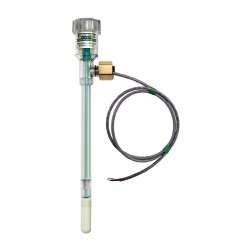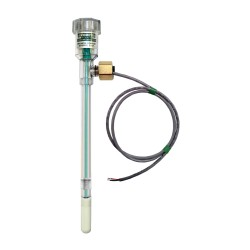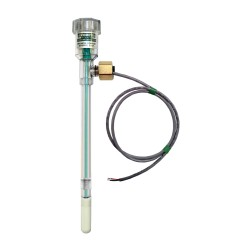
Irrometer MLT Mid-Length Tensiometer
Professional mid-length tensiometer for measuring soil water tension in the middle root zone. Essential for orchards, vineyards, field crops, and deep-rooted vegetables.
Product Highlights
View all in Specifications tabOverview
The Irrometer MLT (Mid-Length Tensiometer) is a professional-grade instrument designed for monitoring soil water tension in the middle root zone at depths of 18-24 inches (45-60 cm). This mid-range model is ideal for monitoring water storage zones, verifying irrigation penetration depth, and managing irrigation for field crops, orchards, vineyards, and deep-rooted vegetables.
Key Features
- Direct Measurement: Measures actual soil water tension experienced by plant roots
- Mid-Zone Monitoring: Optimized for 18-24 inch (45-60 cm) depths
- Fast Response: Rapid equilibration with soil moisture changes
- Easy Reading: Clear vacuum gauge with centibar scale
- Proven Technology: Time-tested design used worldwide since 1951
- No Calibration: Works in all soil types without calibration
- Visual Indication: Quick visual check of soil moisture status
- Professional Grade: Durable construction for long-term field use
Applications
- Orchard and vineyard irrigation
- Field crop management (corn, cotton, alfalfa)
- Deep-rooted vegetable crops
- Soil moisture profiling
- Verifying irrigation depth penetration
- Water storage zone monitoring
- Preventing deep percolation losses
- Multi-depth irrigation management
- Agricultural research
- Irrigation system evaluation
Technical Specifications
The Irrometer MLT tensiometer uses a water-filled tube with a porous ceramic cup positioned at the measurement depth. Water moves through the ceramic cup in response to soil moisture conditions, creating a vacuum that is measured by the gauge at the top. The reading directly indicates the soil water tension at the ceramic cup depth.
Understanding Mid-Zone Monitoring
The middle root zone serves critical functions:
Water Storage
- Buffer zone: Stores water between irrigation events
- Root access: Active water uptake zone for mature plants
- Drought reserve: Water available during stress periods
- Efficiency indicator: Shows if irrigation water is penetrating deep enough
Irrigation Management
- Depth verification: Confirms water reaching this zone
- Over-irrigation detection: Indicates excessive deep percolation
- Root zone wetting: Ensures complete profile wetting
- Storage assessment: Monitors water reserves between irrigations
Tensiometer Reading Interpretation
Soil Moisture Zones
- 0-10 cb: Saturated, possible over-irrigation
- 10-25 cb: Field capacity, optimal moisture
- 25-40 cb: Adequate moisture, good for most crops
- 40-60 cb: Moderate stress, irrigation needed
- 60-70 cb: High stress, irrigate promptly
- 70-80 cb: Severe stress, immediate irrigation required
Comparing Depths
Using MLT with other depths reveals:
- Shallow drier than mid: Recent irrigation needed
- Mid drier than shallow: Insufficient irrigation depth or amount
- Both dry together: Significant water stress, irrigate soon
- Shallow wet, mid dry: Recent light irrigation, may need deeper watering
Installation Guidelines
Selecting Installation Depth
The MLT model is designed for mid-zone depths:
- Field crops: 45-50 cm (18-20 inches)
- Orchards: 50-60 cm (20-24 inches)
- Vineyards: 45-55 cm (18-22 inches)
- Deep vegetables: 45-60 cm (18-24 inches)
Installation Procedure
- Auger hole: Use appropriate length auger for depth
- Prepare slurry: Mix native soil with water to mud consistency
- Fill hole: Pour slurry into augered hole
- Insert tensiometer: Push firmly to specified depth
- Verify depth: Measure exposed tube length to confirm depth
- Fill with water: Remove cap and fill tube completely
- Remove air: Tap tube to release trapped air bubbles
- Seal: Replace cap and tighten securely
- Mark location: Flag or mark for easy location
- Equilibrate: Wait 24-48 hours before taking first reading
Site Selection
- Representative area of irrigation zone
- Within active root zone
- Avoid soil anomalies or drainage patterns
- Away from irrigation emitters (prevent saturation)
- Multiple tensiometers for field variability
- Accessible for regular monitoring
Reading and Maintenance
Taking Readings
Regular Monitoring Schedule:
- Active growth: Daily readings
- Peak demand periods: Twice daily if critical
- Moderate conditions: Every 2-3 days
- Before irrigation: Check current status
- After irrigation: Verify water penetration (24-48 hrs later)
Irrigation Trigger Points by Crop
Field Crops:
- Corn: 50-60 cb (vegetative), 40-50 cb (reproductive)
- Cotton: 50-70 cb (vegetative), 40-50 cb (flowering/boll)
- Alfalfa: 40-60 cb between cuttings
Orchards:
- Citrus: 40-60 cb (most of season)
- Stone fruits: 40-50 cb (fruit development)
- Apples/Pears: 50-70 cb (depending on stage)
Vineyards:
- Table grapes: 40-60 cb
- Wine grapes: 50-80 cb (controlled stress for quality)
Maintenance Requirements
Weekly Tasks:
- Check water level visibility in tube
- Verify gauge reading properly
- Top off water if needed
- Record readings
Monthly Tasks:
- Remove cap and refill if water low
- Check for and release air bubbles
- Inspect for physical damage
- Verify gauge function
Seasonal Tasks:
- Deep clean ceramic cup if needed
- Complete water replacement
- Check all seals and gaskets
- Test gauge accuracy
Refilling Procedure
- Unscrew and remove cap
- Fill tube with clean water to near top
- Tap tube firmly to dislodge air bubbles
- Top off water after bubbles released
- Replace cap and tighten securely
- Check gauge responds within hours
Multi-Depth Strategy
Optimal Configuration
Install tensiometers at multiple depths:
- Shallow (SR, 6-12”): Root activity zone, quick irrigation response
- Mid (MLT, 18-24”): Water storage, penetration verification
- Deep (LT, 36-48”): Deep storage, drainage monitoring
Benefits of Multi-Depth Monitoring
- Complete profile: Full picture of soil moisture distribution
- Irrigation optimization: Right amount and frequency
- Efficiency: Prevent under and over-watering
- Water conservation: Minimize deep percolation losses
- Root development: Encourage deeper rooting
- Problem diagnosis: Identify irrigation system issues
Reading Patterns and Interpretations
Pattern 1: All depths dry
- Soil profile depleted
- Irrigate immediately
- May need longer irrigation duration
Pattern 2: Shallow dry, mid/deep adequate
- Light, frequent irrigation strategy
- May be promoting shallow roots
- Consider less frequent, deeper irrigation
Pattern 3: Shallow wet, mid/deep dry
- Insufficient irrigation depth
- Increase irrigation duration
- Check system uniformity
Pattern 4: All depths wet
- Possible over-irrigation
- Check deep tensiometer for drainage
- Reduce irrigation amount or frequency
Troubleshooting
Common Issues and Solutions
Gauge Remains at Zero:
- Saturated soil (normal in wet conditions)
- Air leak in system (check cap, tube)
- Needs refilling
Gauge Remains at 80+ cb:
- Very dry soil (correct - irrigate!)
- Tension broke (refill and wait)
- Ceramic cup clogged (clean or replace)
Slow Response to Irrigation:
- Water not reaching this depth yet (normal)
- Insufficient irrigation amount
- Soil layers restricting water movement
- Check shallower tensiometer responds first
Reading Different from Shallow Tensiometer:
- Normal - different depths have different moisture
- Indicates water distribution pattern
- Use for irrigation depth assessment
Seasonal Management
Spring
- Reinstall after winter storage
- Check soil profile moisture from winter
- Adjust depths if needed for new crops
- Establish baseline readings
Summer
- Most critical monitoring period
- Refill more frequently in heat
- Daily monitoring during peak demand
- Watch for stress development
Fall
- Monitor as crop water needs decline
- Track soil recharge from rainfall
- Prepare for harvest
- Plan for winter removal
Winter
- Remove before freezing in cold climates
- Clean and inspect
- Store cups in water
- Plan next season installation
Advanced Applications
Irrigation Scheduling
Use tensiometer readings to:
- Determine irrigation start time
- Calculate irrigation duration needed
- Verify actual vs. intended application depth
- Adjust for crop growth stage
- Account for weather and ET changes
Deficit Irrigation
In water-limited situations:
- Allow controlled stress between irrigations
- Monitor stress levels precisely
- Time stress to non-critical growth stages
- Maximize water productivity
System Evaluation
Tensiometers help evaluate:
- Distribution uniformity
- Irrigation system performance
- Emitter/sprinkler spacing adequacy
- System capacity sufficiency
Water Conservation Impact
Proper use of mid-depth tensiometers:
- Reduce over-irrigation: Prevent excess deep percolation
- Optimize timing: Irrigate when truly needed
- Right amount: Apply sufficient but not excessive water
- Save 20-40%: Typical water savings with proper management
- Protect environment: Minimize runoff and leaching
- Lower costs: Reduce water, energy, and fertilizer expenses
Professional Applications
The MLT tensiometer is essential for:
- Commercial orchard management
- Vineyard irrigation precision
- Field crop production
- Agricultural consultants
- Irrigation district programs
- Research and demonstration projects
- Teaching soil moisture principles
- Water management agencies
Integration with Other Tools
Combine MLT tensiometers with:
- Weather stations: ET-based scheduling
- Flow meters: Verify application amounts
- Soil moisture sensors: Validate other sensor types
- Crop monitoring: Correlate moisture with crop response
- Dataloggers: Automated continuous monitoring
Quality and Durability
Irrometer tensiometers feature:
- USA manufacturing
- Quality control testing
- Field-proven durability
- Replaceable components
- Technical support availability
- Extensive documentation
- Over 70 years of refinement
Related Products
Other solutions in the soil category


